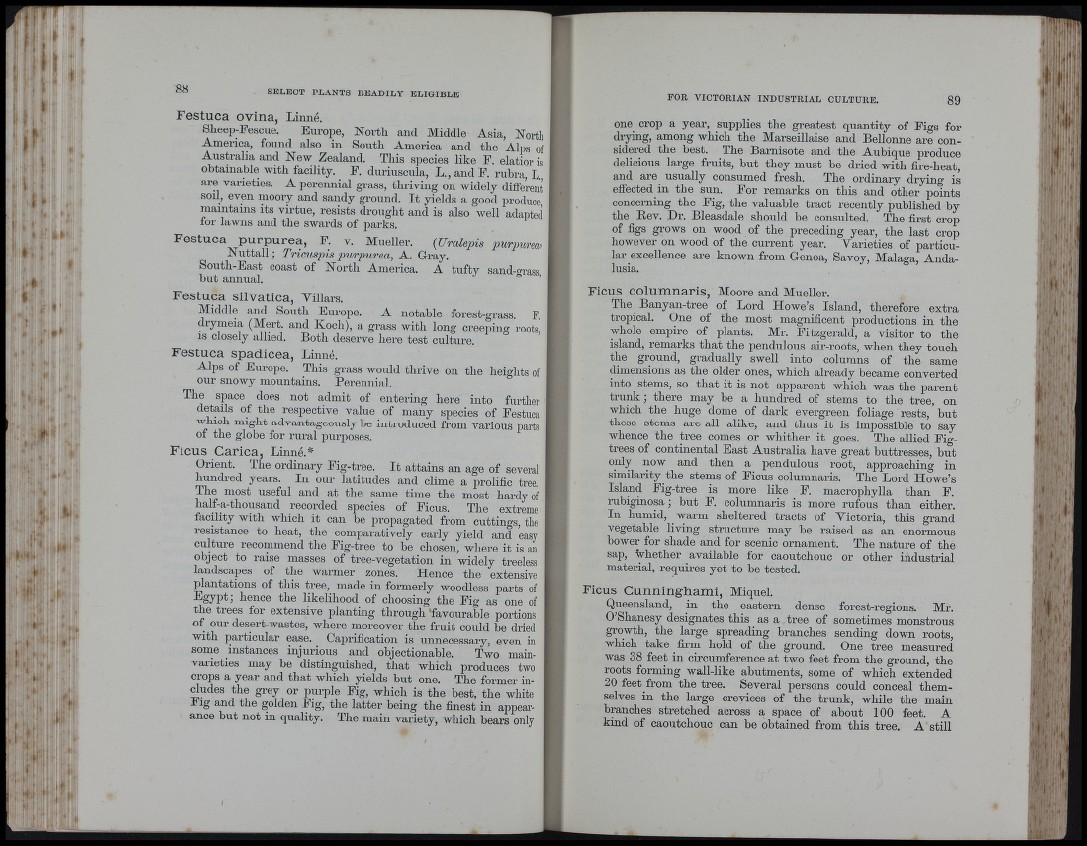
Il '
Festuca ovina, Linné.
Sheep-Fescue. Europe, Nortli and Middle Asia, North
America, found also in South America and the Alps of
Australia and New Zealand. This species like E. elatior is
obtainable with facility. F. duriuscula, L., and F. I’ubra, L.
are varieties. A perennial grass, thriving on widely different
soil, even moory and sandy ground. I t yields a good produce
maintains its virtue, resists drought and is also well adapted
for lawns and the swards of parks.
Festuca purpurea, F. v. Mueller. {Uralepis purpurm^
N u tta ll; Tricuspis purpurea, A. Gray.
South-East coast of North America. A tufty sand-orass
but annual. ’
Festuca silvática, Villars.
Middle and South Europe. A notable forest-grass. F,
drymeia (Mert. and Kocli), a grass with long creeping roots
IS closely allied. Both deserve here test culture. '
Festuca spadicea, Linné.
Alps of Europe. This grass would thrive on the heights of
onr snowy mountains. Perennial.
The space does not admit of entering here into further
details of the respective value of many species of Festuca
which might advantageously be introduced from various parts
of the globe for rural puiqioses.
Ficus Carica, Linné.*
Orient. The ordinary Fig-tree. I t attains an age of several
hundred years. In our latitudes and clime a prolific tree.
The most useful and at the same time the most hardy of
half-a-thousand recorded species of Eicus. The extreme
facility with which it can be propagated from cuttings, the
resistance to heat, the comparatively early yield and easy
culture recommend the Eig-tree to be chosen, where it is an
object to raise masses of tree-vegetation in widely treeless
landscapes of the warmer zones. Hence the extensive
plantations of this tree, made in formerly woodless parts of
Egypt; hence the likelihood of choosing the Fig as one of
the trees for extensive planting through favourable portions
of our desert-wastes, where moreover the fruit could be dried
with particular ease. Caprification is unnecessary, even in
some instances injurious and objectionable. Two main-
varieties may be distinguished, that which produces two
crops a year and that which yields but one. The former indudes
the grey or purple Eig, which is the best, the white
Eig and the golden Eig, the latter being the finest in appearance
but not in quality. The main variety, which bears only
one crop a year, supplies tbe greatest quantity of Figs for
drying, among which tbe Marseillaise and Bellonne are considered
the best. The Barnisote and the Aubique produce
delicious large fruits, but they must be dried with fire-heat,
and are_ usually consumed fresh. The ordinary drying is
effected in the sun. For remarks on this and other points
concerning the Eig, the valuable tract recently published by
the Rev. Dr. Bleasdale should be consulted. Tbe first crop
of figs grows on wood of the preceding year, the last crop
however on wood of the current year. Varieties of particular
excellence are known from Genoa, Savoy, Malaga, Andalusia.
F icu s c o lu m n a r is , Moore and Mueller.
The^ Banyan-tree of Lord Howe’s Island, therefore extra
tropical. One of the most magnificent productions in the
whole empire of plants. Mr. Fitzgerald, a visitor to the
island, remarks th a t the pendulous air-roots, when they touch
the ground, gradually swell into columns of the same
dimensions as the older ones, which already became converted
into stems, so that it is not apparent which was tbe parent
t runk; there may be a hundred of stems to the tree, on
which the huge dome of dark evergreen foliage rests, but
these stems are all alike, and thus it is impossible to say
whence the tree comes or whither it goes. The allied Fig-
trees of continental East Australia have great buttresses, but
only now and then a pendulous root, approaching in
similarity the stems of Eicus columnaris. Tbe Lord Howe’s
Island Eig-tree is more like E. macrophylla than F.
rubiginosa; but E. columnaris is more rufous than either.
In humid, warm sheltered tracts of Victoria, this grand
vegetable living structure may be raised as an enormous
bower for shade and for scenic ornament. The nature of the
sap, whether available for caoutchouc or other industrial
material, requires yet to be tested.
Ficus Cunninghami, Miquel.
Queensland, in the eastern dense forest-regions. Mr.
O’Shanesy designates this as a tree of sometimes monstrous
growth, the large spreading branches sending down roots,
which take firm hold of the ground. One tree measured
was 38 feet in circumference at two feet from the ground, the
roots forming wall-like abutments, some of which extended
20 feet from the tree. Several persons could conceal themselves
in the large crevices of the trunk, while the main
branches stretched across a space of about 100 feet. A
kind of caoutchouc can be obtained from this tree. A still
Ml
.„I
I» .!